Paraguay << PAR uh gway or PAR uh gwy >> is a small landlocked country near the center of South America. It shares borders with Argentina, Bolivia, and Brazil. The Paraguay River flows through Paraguay from north to south. It divides the country into two sharply different land regions. West of the river lies the Chaco, a flat, thinly settled area of coarse grasses, scrub forests, and salt marshes. Eastern Paraguay, east of the river, has rolling hills, fertile soil, and forests.
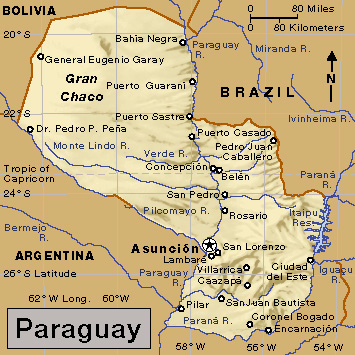
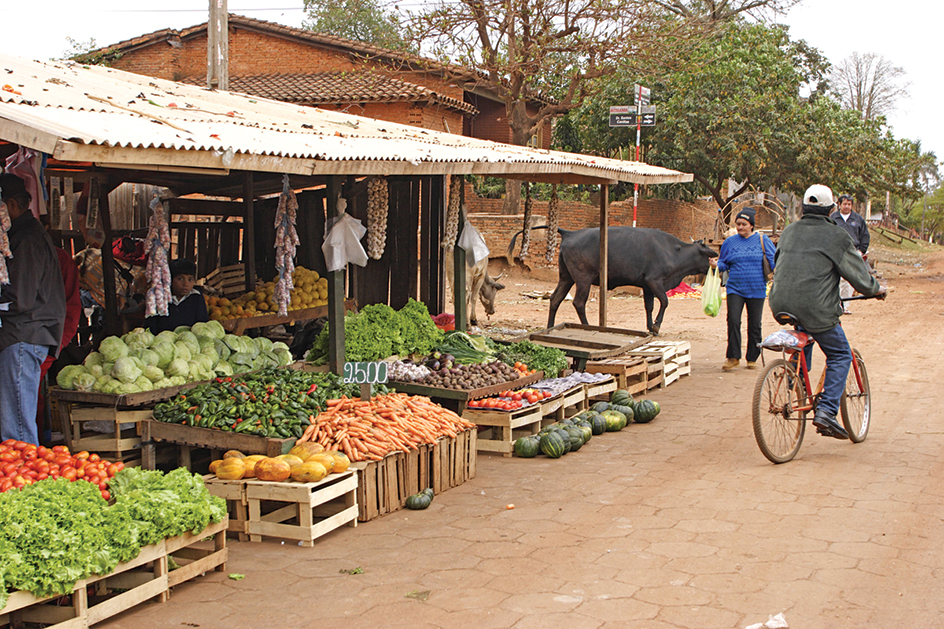
The great majority of Paraguayans live in the eastern part of the country. About a third of them live in or near Asunción, the capital and most populous city. Almost all Paraguayans have both Guarani and European (mainly Spanish) ancestry. The Guarani were early inhabitants of what is now Paraguay. They intermarried with Spanish settlers, who began to arrive in the 1500’s. Most Paraguayans speak both Guarani and Spanish. Nearly all the people are Roman Catholics.
Paraguay is a poor country with an economy based chiefly on agriculture and forestry. Most rural Paraguayans make a bare living farming. The country’s most valuable resources are fertile soil, forests, water, and vast hydroelectric power potential.
Spain ruled Paraguay until 1811, when Paraguay declared its independence. Over the years, the country has suffered from two terrible wars with neighboring nations and from frequent struggles for power among rival political groups.
Government
National government.
Paraguay’s Constitution, adopted in 1992, provides for a democratic form of government. Under the Constitution, voters elect the president, Paraguay’s head of government, to a five-year term. The president may not be reelected. The president appoints a cabinet called the Council of Ministers. The ministers head the government departments and help the president carry out the operations of government.

Paraguay’s legislature, called the National Congress, consists of a 45-member Senate and an 80-member Chamber of Deputies. Voters elect the members to five-year terms. The law requires all citizens from 18 to 75 years old to vote. Older citizens may vote voluntarily.
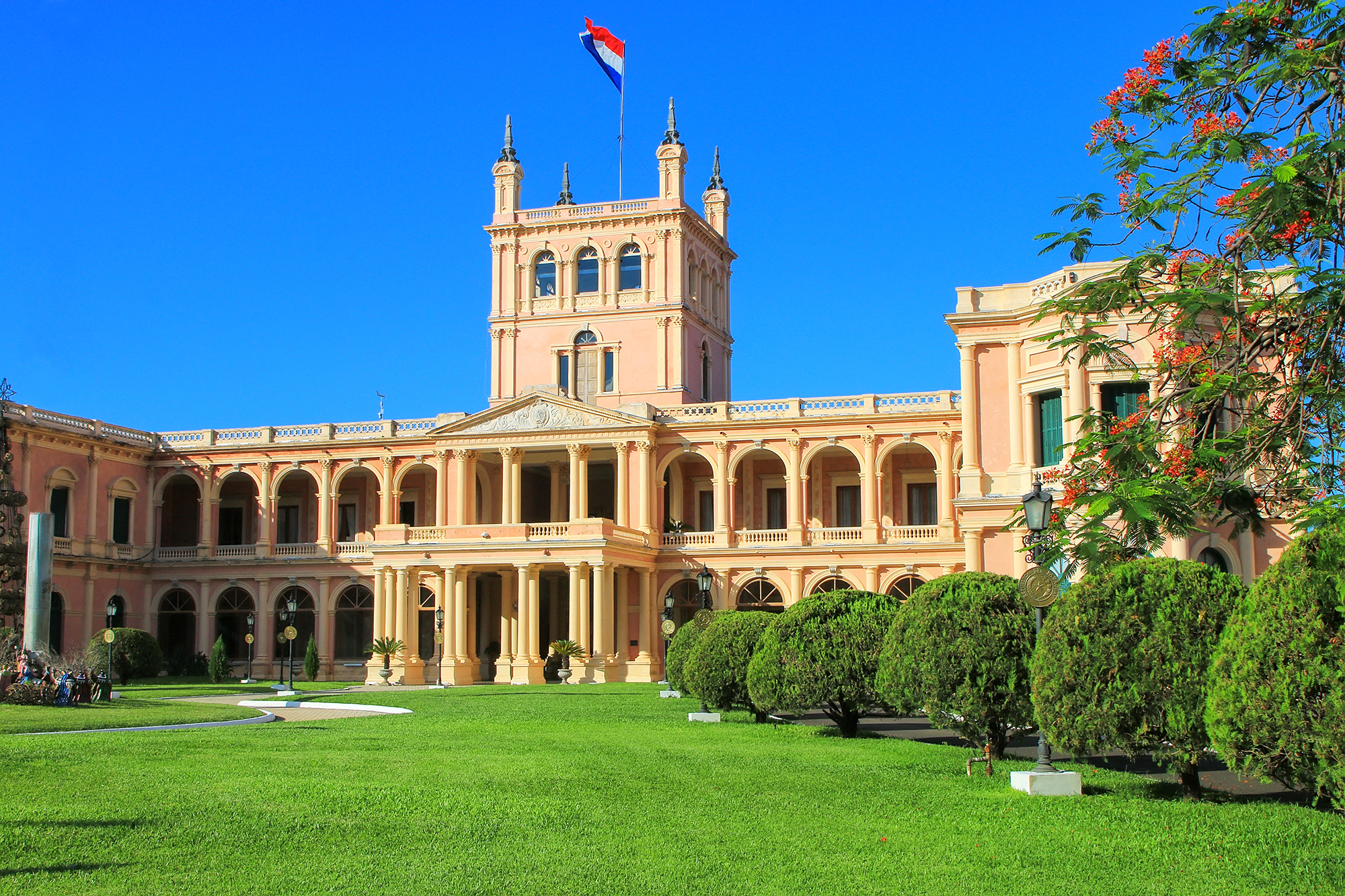
Local government.
For the purposes of local government, Paraguay is divided into 17 departments and the capital city of Asunción. Voters elect a governor to head each department. The departments are subdivided into smaller units of government called municipalities.
Courts.
The Supreme Court of Justice is Paraguay’s highest court. It has nine justices, who are appointed by the Senate from a list of candidates proposed by the Council of the Magistracy. Supreme Court justices serve until age 75.
Armed forces.
Paraguayan men are drafted into the armed forces at age 18. They serve one year in the country’s army or two years in the navy.
People
Population and ancestry.
More than 95 percent of Paraguay’s people live in the eastern part of the country. The rest live in the west, known as the Chaco, where poor soil, a dry climate, and a lack of roads have discouraged settlement.
Indigenous (native) people lived in what is now Paraguay long before the first Spanish settlers arrived in the 1500’s. Over the years, a large number of Indigenous people and Spaniards intermarried. Today, about 95 percent of all Paraguayans are mestizos (people with both European and Indigenous ancestry). Many people are descended from immigrants who came to Paraguay from such countries as China, Germany, Italy, Japan, Korea, and Spain. A small number of people with fully Indigenous ancestry live in the Chaco.
Languages.
Paraguay has two official languages—Spanish and Guarani, an Indigenous language. Spanish is the principal language used in government, law, international commerce, education, and newspapers. However, most people in Paraguay prefer to use Guarani in everyday conversation, especially in rural areas.
Way of life.
Paraguay has a large, poor lower class. It consists of nearly all rural people and most city dwellers. Middle-class Paraguayans, most of whom live in urban areas, form a small but growing part of the population. The nation’s tiny upper class consists chiefly of government officials, military leaders, wealthy landowners, and business people.
Rural life.
About 40 percent of Paraguay’s people live in rural areas. Most Paraguayans who live in rural areas are farmers who grow food mainly for their own families. Other rural Paraguayans work on cattle ranches, on large farms that produce crops for export, in forestry, or in small factories that process agricultural products.
Most rural Paraguayans live in one-room houses called ranchos. A typical rancho has a dirt floor; reed, wood, or brick walls; and a thatched roof sloped to carry off heavy rains. A separate or attached shed serves as a kitchen. Few ranchos have indoor plumbing.
City life.
About 60 percent of Paraguay’s people live in cities and towns. Asunción, the capital, is the largest city. It has about half a million people. The Greater Asunción area—which includes other cities, such as Fernando de la Mora, Lambaré, Luque, and San Lorenzo—has nearly 2 million people. City dwellers include craftworkers, unskilled laborers, factory workers, government employees, office workers, shopkeepers, and professional people. Urban Paraguayans generally have a higher living standard than do the people in rural areas. The cities have better schools, more medical facilities and other services, and various cultural and recreational activities.
Many city people live in small brick or stucco houses with red tile roofs and windows covered by iron grillwork. The poorest people live in shacks built of scraps of wood or metal. Unlike many other large Latin American cities, Asunción does not have sprawling slum areas. But some slums do exist along the Paraguay River.
Food and drink.
Paraguayans eat a great deal of meat, especially beef. Beef often is cooked with vegetables in a stew called puchero. Another common food is cassava, a starchy root vegetable. Cassava may be boiled or ground into flour and made into a bread called chipa. Sopa paraguaya, often served on special occasions, consists of corn meal cooked with eggs, milk, onions, and cheese. A popular beverage is a tea made from the maté (also called yerba maté) plant, a small evergreen tree that grows in eastern Paraguay. The tea is called maté when served hot and tereré when served cold.
Recreation.
Soccer is the most popular sport in Paraguay. The people also enjoy such sports as basketball and volleyball. Paraguayans celebrate religious holidays with festivals that often include music, dancing, parades, and religious processions.
Religion.
About 90 percent of Paraguayans are Roman Catholics. The Constitution recognizes Catholicism as the state religion, but it guarantees freedom of worship. Protestants, many of whom are Mennonites, make up about 5 percent of the population.
Education.
Almost all Paraguayans over age 15 can read and write. The law requires children from ages 7 through 13 to attend school. However, the law is not strictly enforced, especially in rural areas. Some rural children do not attend school or drop out to help their families farm the land. Numerous rural areas have teacher shortages, and some have no schools at all.
Paraguay has a number of universities as well as post-secondary schools that provide job and technical training. The main universities are the National University of Asunción and the Catholic University of Our Lady of the Assumption. The Catholic University has campuses in Asunción and several other cities.
The arts.
Various Paraguayan arts reflect the influence of the country’s Guarani and immigrant populations. Traditional Paraguayan music is renowned throughout South America. It features singing accompanied by guitars and the Paraguayan harp, which is smaller than a concert harp and is played mostly with the fingernails. The music includes slow songs called guaranias and livelier Paraguayan polkas. Artists commonly portray Guarani culture in their paintings, and craftworkers use Guarani designs in producing fine pottery and handwoven baskets. Paraguay’s most famous handicraft is ñandutí lace. In the Guarani language, ñandutí means spider web. The lace’s complicated patterns often represent flowers, animals, and other familiar objects. Skilled craftswomen made the town of Itauguá famous as the traditional center of ñandutí production. Loading the player...
Paraguayan Indigenous music
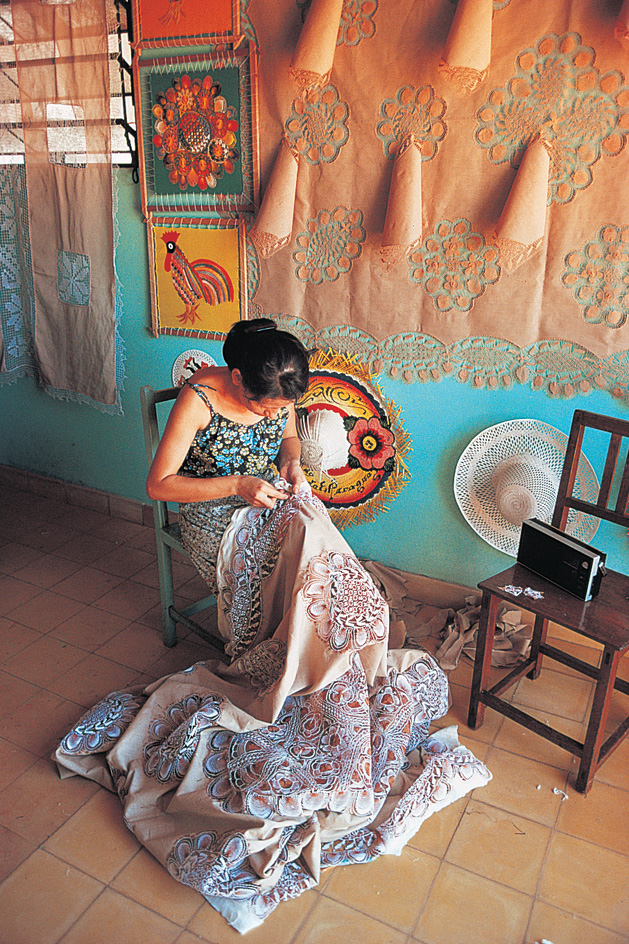
Literature written in the Guarani language is fairly uncommon. Although Spanish missionaries developed a written form of Guarani, the use of the language has remained primarily oral. Paraguay has a rich tradition of Spanish literature, much of which draws on the country’s turbulent history.
The land and climate
Land regions.
The Paraguay River flows southward through Paraguay. It divides the country into two major regions: (1) the Chaco, officially called Occidental Paraguay, and (2) Eastern Paraguay, officially called Oriental Paraguay.
The Chaco
stretches westward from the Paraguay River. It is part of the Gran Chaco, a large region that extends into Argentina and Bolivia. The Chaco occupies about three-fifths of Paraguay but has less than 5 percent of its population. Coarse grasses, scrub forests, and thorny shrubs cover much of the Chaco. The forests include quebracho trees. Quebrachos are a source of tannin, a chemical used to process leather.
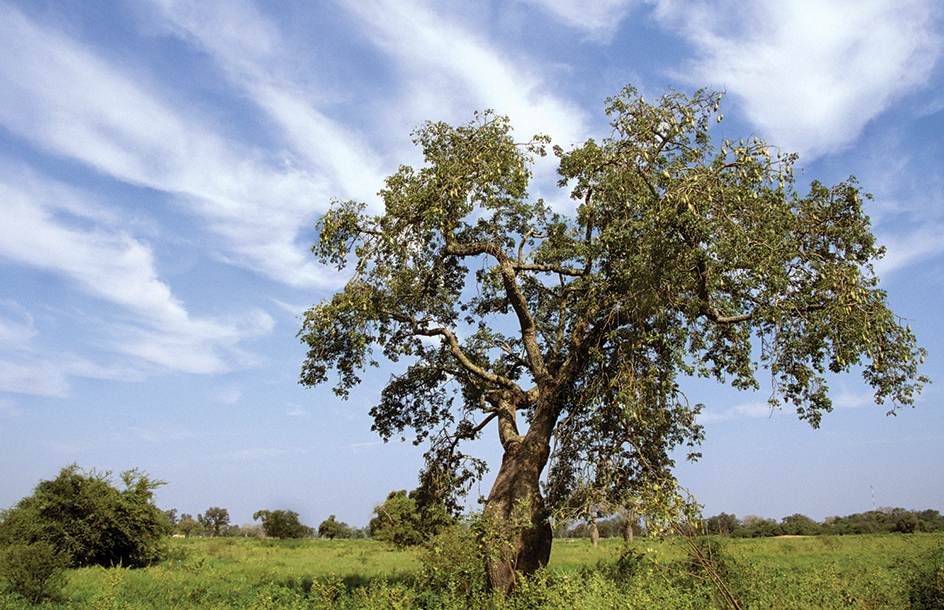
Several slow-moving rivers flow through the southern and eastern Chaco. The Pilcomayo River forms Paraguay’s southwestern border with Argentina. The Pilcomayo and other rivers in the Chaco often overflow after heavy rains in the summer. Some of the rivers disappear during the winter dry season, and salt marshes form. In much of the Chaco, the underground water is too salty for drinking or irrigation. Cattle ranches occupy parts of the region, mainly in the south. German-speaking people of the Mennonite faith have established several farming communities in the central Chaco. In addition, scattered groups of Guarani live in remote parts of the region. However, most of the Chaco is uninhabited.
Eastern Paraguay
lies between the Paraguay and Paraná rivers. The Paraná forms part of Paraguay’s border with Argentina and Brazil. It flows through Argentina to the Atlantic Ocean, thus providing Paraguay with an outlet to the sea. The Paraná Plateau occupies the eastern third of the region. The rest of the region consists of low, grassy plains and hills.
More than 95 percent of all Paraguayans live in Eastern Paraguay. Most of them live along the Paraguay River or in the southwestern part of the region, where small towns and farming villages dot the rolling countryside. Asunción lies on the Paraguay River, near the place where it meets the Pilcomayo River.
Climate.
Most of Paraguay has a warm, humid climate. The Chaco is the hottest and driest part of the country, and the Paraná Plateau is the coolest and wettest. Paraguay lies south of the equator, and so its seasons are opposite those in the Northern Hemisphere. Temperatures in Asunción average 65 °F (19 °C) in July and 84 °F (29 °C) in January.
Eastern Paraguay receives about 50 to 65 inches (127 to 166 centimeters) of rain annually. The rain falls throughout the year in the region. The Chaco receives about 20 to 40 inches (51 to 102 centimeters) of rain yearly. It often has winter droughts and summer floods.
Economy
Paraguay has one of South America’s less-developed economies. Service industries and agriculture, including forestry, account for most of the gross domestic product (GDP)—the total value of all goods and services produced in the country yearly. Most businesses and industries are privately owned. However, the national government plays a major role in economic planning and development. It also owns firms in such fields as banking, energy production, manufacturing, and transportation. Many people work in the informal economy that is outside of government control. They generally hold low-income jobs, for example as street vendors.
Service industries
account for over half of both Paraguay’s GDP and its employment. Many of the workers are employed by banks; government agencies; health care facilities; schools; and stores, restaurants, and hotels. Others work in such fields as transportation and communication.
Agriculture and forestry
largely form the basis of Paraguay’s economy. They account for about one-fifth of the GDP and employ about one-fourth of all workers. Beef and milk are among the leading agricultural products. Large cattle ranches cover parts of the Chaco and much of Eastern Paraguay. Hogs, poultry, and sheep are raised primarily in Eastern Paraguay. Eastern Paraguay has rich soil. Soybeans are the country’s chief agricultural product, and Paraguay is a leading soybean-producing country. Farmers also grow such crops as beans, cassava, corn, cotton, oranges, rice, sugar cane, tobacco, and wheat. 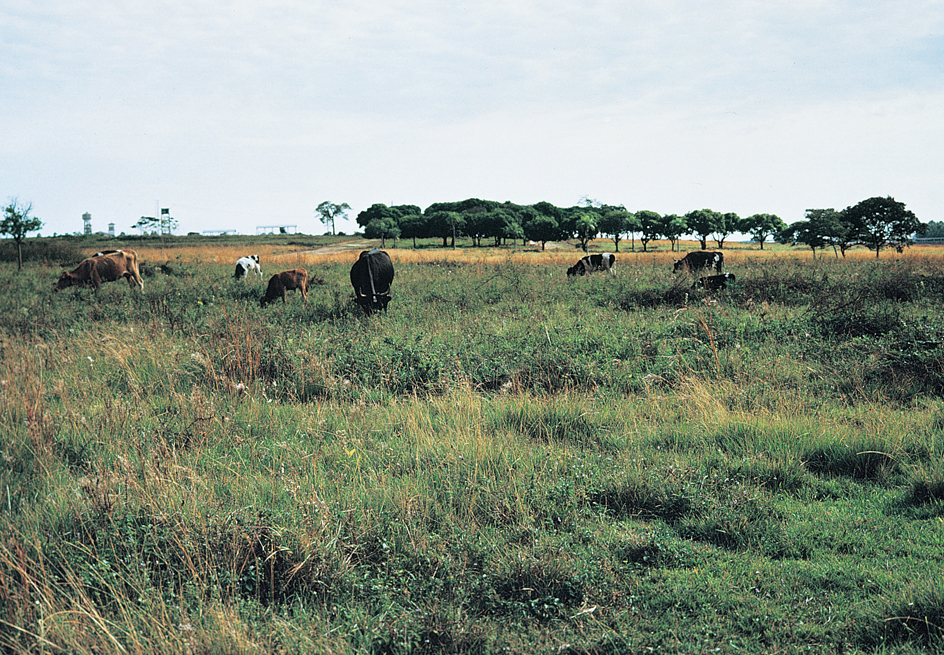
Farms occupy only about a third of the land that could be used in Paraguay to grow crops. One reason is that landownership is highly concentrated among few people, and much of the land on big estates is not cultivated. Many farmers do not own land. Those who do generally have small plots on which they grow food for their families and perhaps for the local market.
Forests once covered much of Eastern Paraguay. However, deforestation (destruction of forests) has become a major problem since the mid-1900’s. Most of the forests in Eastern Paraguay have been cut down to make way for cattle ranching and soybean production. The most economically important trees include palms; quebrachos, which grow in the Chaco; and wild citrus trees.
Manufacturing.
Much of Paraguay’s manufacturing is dedicated to processing its natural resources. Major manufactured goods include cement, processed food and beverages, steel, textiles, and wood products. The largest factories are in or near Asunción and Ciudad del Este.
Energy sources.
Hydroelectric plants on the Acaray and Paraná rivers provide plentiful electric power. The country also has enormous potential for further hydroelectric power development. The Itaipú Dam power plant, built by Paraguay and Brazil on the Paraná River, is one of the world’s largest hydroelectric power projects. It began generating electric power in 1984. A small amount of energy comes from oil. However, Paraguay has no oil reserves and must rely on imports. 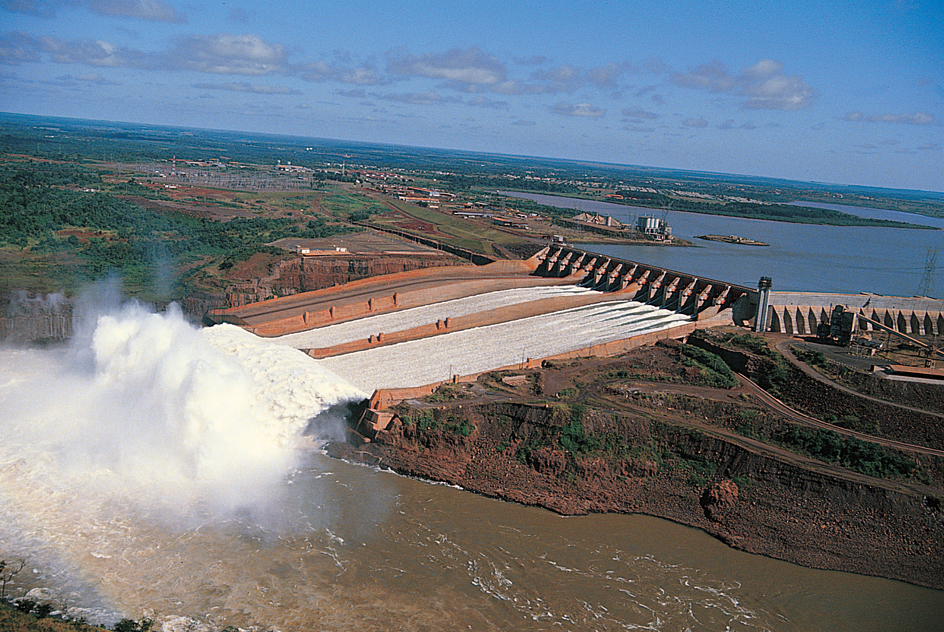
Trade.
Paraguay imports more than it exports. Leading imports include chemicals, electronics, machinery, motor vehicles, and petroleum products. The country’s exports include leather, meat, soybeans, tobacco, vegetable oils, and wood products. Paraguay trades mainly with Argentina, Brazil, China, the United States, and Uruguay. Illegal trade with Argentina and Brazil also is important to the economy. Contraband goods include alcohol, appliances, cigarettes, electronics, and timber. Some smuggling takes place to avoid customs taxes. Trade in stolen and counterfeit goods and such illegal activities as gun running or drug trafficking also occur.
Transportation and communication.
Rivers serve as an important means of transportation in Paraguay. Asunción and Villeta, two of the country’s leading ports, lie on the Paraguay River. Both ports are about 1,000 miles (1,600 kilometers) from the Atlantic Ocean. To reach the ocean from these cities, boats travel down the Paraguay to the Paraná River, which flows through Argentina and empties into the Atlantic.
Paraguay’s major cities are connected by paved highways. Friendship Bridge spans the Paraná River at the city of Ciudad del Este. It links the Paraguayan road system to a Brazilian highway that runs to the port of Paranaguá on the Atlantic coast. Asunción and Ciudad del Este have international airports.
Paraguay has one state-owned, and dozens of privately owned, radio stations. The country’s television stations are all privately owned. Paraguay’s leading daily newspapers include ABC Color, La Nación, and Última Hora.
History
Early days.
Many Indigenous groups lived in what is now Paraguay before Europeans arrived there. Most Indigenous groups of the Chaco region, in what is now western Paraguay, lived by hunting, fishing, and gathering wild plants. They belonged to several language groups. Most of the Indigenous groups in eastern Paraguay belonged to the Tupi-Guarani language group. They grew corn and other crops, hunted, fished, and gathered wild plants.
In the early 1500’s, Spanish and Portuguese explorers became the first Europeans to reach Paraguay. They were searching for a route across the continent, by which they could reach Peru and its treasures of silver and gold. A Spaniard named Juan de Salazar y Espinoza founded Asunción in 1537. Under the leadership of Domingo Martínez de Irala, the settlement of Asunción became the seat of government for all of Spain’s colonies in southeastern South America.
Jesuit missionaries
began arriving in Paraguay in 1588. They sought to convert the Indigenous Guarani people to Catholicism. They organized mission settlements called reducciones, where the Guarani lived and worked. The Jesuits taught the Guarani such skills as carpentry, printing, and weaving. Most of the Guarani farmed the land or tended cattle. In return, they received food, clothing, and other goods. The reducciones became prosperous settlements that exported cotton, tobacco, maté, hides, and wood. In the 1730’s, the Jesuits had about 30 reducciones in what are now southeastern Paraguay and nearby regions of Argentina and Brazil, with a total population that peaked at more than 140,000.
Many Spanish colonists came to envy the wealth and power of the Jesuits. They wanted to use the cheap Guarani labor themselves on their farms. The Jesuits, on the other hand, felt they were protecting the Guarani from possible slavery and formed armies to guard the reducciones. Complaints from the colonists about the Jesuits’ power led the Spanish king, Charles III, to expel the Jesuits from all Spanish territory in 1767. The Jesuits left Paraguay, and the reducciones were abandoned. Some Guarani returned to their old ways of life. Others worked on estates of the Spanish colonists.
Independence.
Throughout the 1600’s and 1700’s, many Paraguayans felt that Spain neglected their colony, and they resented the taxes the mother country demanded. In 1776, Spain made Paraguay part of one large colony called the Viceroyalty of La Plata. Buenos Aires, Argentina, became the capital of the viceroyalty. In 1811, Paraguayans overthrew the Spanish governor in Asunción and declared their independence. They formed an assembly to rule their new nation.
In 1814, the assembly chose José Gaspar Rodriguez de Francia, a Paraguayan lawyer, to head the government. Two years later, the assembly made him dictator for life. Francia governed by military force. He reduced the power of the Catholic Church and of upper-class Spaniards in Paraguay. Francia feared that Argentina and Brazil might try to take over Paraguay, so he pursued an extreme isolationist policy. He strictly controlled immigration and trade with other nations. Paraguay was cut off from the rest of the world, but it developed a strong sense of unity and remained independent.
Francia died in 1840. An assembly then chose Carlos Antonio López to govern the country. In 1844, another assembly adopted a republican constitution and named López president. Like Francia, López ruled as a dictator, but he reversed many of Francia’s policies. López encouraged international trade and invited foreign technicians to settle in Paraguay. He passed legislation that gradually abolished slavery and he built roads, railways, a telegraph system, and schools. He also created a powerful army for Paraguay’s defense.
Military ruin.
López died in 1862. The Paraguayan legislature then elected his son Francisco Solano López president with dictatorial powers. Francisco believed that Argentina and Brazil wished to occupy Paraguay and Uruguay, so he signed a defense treaty with Uruguay. In 1864, Paraguay went to war against Brazil to defend Uruguay’s government. After Argentina refused to let Paraguayan troops cross its territory to attack Brazil, López declared war on Argentina as well. In 1865, Brazil helped a new government take hold in Uruguay.
Argentina, Brazil, and the new government in Uruguay joined forces in 1865, and they fought Paraguay in the War of the Triple Alliance, also called the Paraguayan War. The war lasted until 1870, when López was killed and Paraguay surrendered. The war left Paraguay in ruins. Some historians estimate that the country lost about 60 percent of its prewar population, including nearly 90 percent of its men. Paraguay also lost a fourth of its territory. After the war, power struggles among rival political groups plagued the country. More than 30 presidents headed Paraguay’s government from 1870 to 1932.
A long-running dispute over ownership of the Chaco region led Paraguay into war with Bolivia in 1932. Both countries suffered many casualties before Paraguay emerged victorious. The two nations agreed on a truce in 1935. They signed a final settlement in 1938 that gave Paraguay new territory in the Chaco.
Political unrest
continued to trouble Paraguay after the Chaco War. A series of presidents governed the country amid widespread complaints of low living standards, inadequate public services, and poor working conditions. Paraguay’s economy improved during World War II (1939-1945), when the United States provided loans and other aid. Paraguay declared war on Germany and Japan in 1945, but no Paraguayan troops fought in the war.
Civil war broke out in Paraguay in 1947, when rebels attempted to overthrow President Higinio Morínigo, who had ruled as a dictator since 1940. The government crushed the revolt after six months of fierce fighting. But the Colorado Party, which had supported Morínigo, then forced the dictator from power and took over the government. Rival factions within the Colorado Party vied for power. Federico Chávez, the leader of one faction, gained control of Paraguay in 1949 and was elected president in 1950. In 1954, General Alfredo Stroessner, commander in chief of the armed forces and leader of another Colorado Party faction, forced President Chávez to resign. Later that year, Stroessner ran unopposed as the Colorado Party candidate for the presidency and won.
Stroessner’s rule and overthrow.
Stroessner ruled Paraguay as a dictator. He used military and police powers to control the Colorado Party and the government. Stroessner was reelected seven times from 1958 to 1988 in elections viewed widely as fraudulent. His government imprisoned and tortured many of its opponents and exiled many others. However, by maintaining political stability, Stroessner was able to attract foreign aid and investments. As a result, a slow program of economic development began. The government undertook projects to modernize agriculture, build roads, and promote new industries. In 1973, Paraguay and Brazil signed the Treaty of Itaipú, in which they agreed to build a huge hydroelectric dam together.
In 1989, Stroessner was overthrown during a coup led by his former friend and ally General Andrés Rodríguez Pedotti. Rodríguez reintroduced democratic elections in May 1989, when he ran successfully as the Colorado Party’s candidate for president.
Paraguay adopted a new constitution in 1992, and the country has held regular democratic, multiparty elections since then. Attempts to overthrow the government in 1996 and 1999 were unsuccessful. Many people claimed that former army general Lino Oviedo was responsible for these attempts, and for the assassination of Vice President Luis María Argaña in 1999.
The early 2000’s.
Former education minister Nicanor Duarte Frutos was elected president in 2003. But he became increasingly unpopular, especially after trying to change the Constitution to allow him to run for a second term.
Fernando Lugo, a former Roman Catholic bishop, was elected president in 2008. His victory ended about 60 years of government control by the right-wing Colorado Party. Lugo was backed by the center-left Patriotic Alliance for Change. In 2012, the National Congress impeached Lugo and abruptly removed him from office. The legislature claimed that Lugo had mishandled a land dispute. Lugo called his removal a coup d’etat—that is, a sudden take-over of government by conspirators. 
In 2013, the Colorado Party returned to power with the election of Horacio Cartes as the country’s president. Colorado Party candidates won Paraguay’s next two presidential elections, in 2018 and 2023. Santiago Peña, an economist and former finance minister, succeeded Mario Abdo Benítez as president in 2023.
